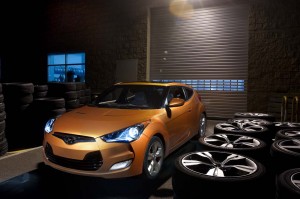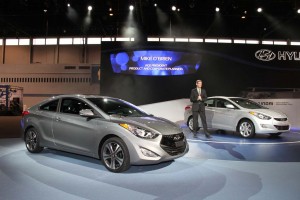
Hyundai may be struggling to boost sales but it continues adding new models, including the 2013 Veloster Turbo.
One of the fastest growth spurts in the auto industry could soon come to a screeching halt.
Hyundai’s sales momentum is running into a serious obstacle as the maker slams into severe constraints on production capacity, cautioned U.S. chief executive officer John Krafcik, the maker struggling to free up supplies from Korea and break production bottlenecks at its plant in Alabama.
“This is something you’re going to hear us say over and over again,” he said. “We have about a 32-day supply, which is the lowest industry,” said Krafcik.
During a preview of three new models, Krafcik notd Hyundai had sold more than 60,000 cars in each of the last three months and is on track to do it again during June. And that despite now having the lowest incentives in the industry. But sales would have run even higher had dealers had enough inventory, Krafcik warned.
“We’re pretty well tapped out,” he said, warning that the capacity constraints will continue for awhile.
The Korean automaker is taking steps to address the situation: notably by adding a third shift at its assembly plant in Alabama, which will provide some relief to capacity limitations and product shortages.
Hyundai has also limited fleet sales so it could deliver more vehicles at retail. The decline in fleet sales and cutbacks in incentives have raised the Hyundai’s average transaction price. But that’s also reflecting a willingness by consumers to pay more for a brand whose perceived value has improved measurably, added Krafcik.
One reason, he said, is Hyundai’s strategy of emphasizing fuel efficiency. “American consumers are attracted by higher efficiency,” he added.
In general, Hyundai’s products, such as the Genesis coupe and sedan, Elantra and Veloster have gained market share in their respective segments. On the car side, the maker’s share is now in the 5.5% range.
The numbers underscore Hyundai’s strength at the retail level in passenger cars – but the South Korean automaker still faces challenges in the truck and crossover segments where it hasn’t done nearly as well, with its market share hovering closer to 2%.
Despite its product shortages, Hyundai isn’t ready to rely solely on existing products. This week, it gave the automotive media a chance to drive three new variants, in fact.
That includes two versions of its strong-selling Elantra, a coupe and a turbocharged sedan. It is also adding a turbo version of the quirky little Veloster model. All three new offerings will reach U.S. showrooms over the summer.

